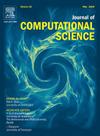Influence of blood-related parameters for hyperthermia-based treatments for cancer
IF 3.1
3区 计算机科学
Q2 COMPUTER SCIENCE, INTERDISCIPLINARY APPLICATIONS
引用次数: 0
Abstract
Hyperthermia is a cancer treatment method that uses controlled heat to induce tumor necrosis while preserving healthy tissue. This study uses computational simulations to investigate the effects of capillary network variability and blood flow dynamics on the thermal response during hyperthermia. A porous media bioheat model, coupled with uncertainty quantification (UQ) techniques using Monte Carlo simulations, was developed to analyze the influence of capillary angles, blood velocity, and capillary density on temperature distribution in biological tissues. The model demonstrates that under a range of physiological uncertainties, tumor tissues consistently reach the critical damage threshold temperature of , while healthy tissues remain below , minimizing collateral damage. To address the computational intensity of solving three-dimensional heat transfer equations with UQ analysis, high-performance computing methods were employed. A parallel implementation using CUDA achieved a speedup exceeding compared to serial processing, while OpenMP achieved a speedup.

血液相关参数对高热治疗癌症的影响
热疗是一种癌症治疗方法,它使用控制的热量来诱导肿瘤坏死,同时保留健康组织。本研究采用计算模拟的方法研究了热疗过程中毛细血管网络变异性和血流动力学对热反应的影响。建立了多孔介质生物热模型,结合蒙特卡罗模拟的不确定定量(UQ)技术,分析了毛细管角、血流速度和毛细管密度对生物组织温度分布的影响。该模型表明,在一系列生理上的不确定性下,肿瘤组织始终达到43°C的临界损伤阈值温度,而健康组织则保持在38°C以下,最大限度地减少了附带损伤。为了解决用UQ分析求解三维传热方程的计算强度问题,采用了高性能计算方法。与串行处理相比,使用CUDA的并行实现实现了超过114倍的加速,而OpenMP实现了16倍的加速。
本文章由计算机程序翻译,如有差异,请以英文原文为准。
求助全文
约1分钟内获得全文
求助全文
来源期刊

Journal of Computational Science
COMPUTER SCIENCE, INTERDISCIPLINARY APPLICATIONS-COMPUTER SCIENCE, THEORY & METHODS
CiteScore
5.50
自引率
3.00%
发文量
227
审稿时长
41 days
期刊介绍:
Computational Science is a rapidly growing multi- and interdisciplinary field that uses advanced computing and data analysis to understand and solve complex problems. It has reached a level of predictive capability that now firmly complements the traditional pillars of experimentation and theory.
The recent advances in experimental techniques such as detectors, on-line sensor networks and high-resolution imaging techniques, have opened up new windows into physical and biological processes at many levels of detail. The resulting data explosion allows for detailed data driven modeling and simulation.
This new discipline in science combines computational thinking, modern computational methods, devices and collateral technologies to address problems far beyond the scope of traditional numerical methods.
Computational science typically unifies three distinct elements:
• Modeling, Algorithms and Simulations (e.g. numerical and non-numerical, discrete and continuous);
• Software developed to solve science (e.g., biological, physical, and social), engineering, medicine, and humanities problems;
• Computer and information science that develops and optimizes the advanced system hardware, software, networking, and data management components (e.g. problem solving environments).
 求助内容:
求助内容: 应助结果提醒方式:
应助结果提醒方式:


